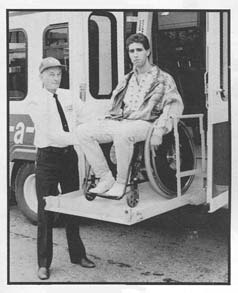

People with disabilities have maintained for years that major obstacles they confront are not a consequence of their disabilities, but arise from number, degree, and complexity of barriers they face. A report to the President and U.S. Congress entitled Town Independence (1986), focuses on federal expenditure of 57 billion dollars for disability benefits and programs-- a sum, the report concludes, which could be substantially reduced if major obstacles in such key areas as employment and transportation were removed.
Based upon its review and assessment of work-related federal laws and programs, the National Council on the Handicapped charged that most federal programs do not encourage employment but instead often penalize the disabled who seek employment. In addition, findings from a 1986 Lou Harris poll found two-thirds of all working-age disabled Americans not working, even though the majority maintained they would like to work. The study concluded that "not working is perhaps the truest definition of what it means to be disabled in American society." No other demographic group has as large a proportion unemployed-- not even young blacks from depressed urban areas.
A second Harris poll (1987) dispelled the myth that cost of employing the disabled is high. Seventy-five percent of managers surveyed indicated the average cost of hiring a disabled person is about the same as the cost of employing a non-disabled person. In fact, the "overwhelming majority of managers give disabled employees a good or excellent rating on their overall job performance."
Another problematic area for the disabled is transportation. Transportation barriers tend to restrict employment option and limit quality of both social and community life. As noted in a congressional office budget report, Representative Tony Coelho (D-California) stated before the Senate Committee on Labor and Human Resources that "more than on million physically disabled, blind, or deaf persons who live within a short walk of transit service cannot physically use it... an additional four million handicapped persons live near transit but find it difficult to use."
Findings of the two Lou Harris polls and recent Congressional hearings moved both the House and Senate to pass the Americans with Disabilities Act of 1989 (ADA)-- a bill which far exceeds intent of the Rehabilitation Act of 1973 and could potentially affect lives of 43 million Americans with disabilities. The ADA has four main titles:
| Employment. | Prohibits discrimination agisnt the disabled in employment, including the obligation to provide reasonable accommodations |
| Transportation. | Ensures wheelchair access to bus, train, and subway cars. |
| Accomodations. | Provides equal access for the disabled across twelve categories of public accomodations including hotels, restaurants, libraries, and convention centers, as well as places of entertainment, exercise, and recreation. |
| Telecommunications. | Requires telephone companies to provide special telephones allowing hearing or voice impaired to place and receive calls from ordinary telephones. |
The bill is in many ways an anamolly-- abold piece of social legislations in a conservative era, an extension of business regulations applauded by a President (Bush) who has worked for regulatory relief (N.Y. Times, 12/17/89).
Critics saythe legislation is essentially an invisible tax which will cost tax payers billions of dollars to implement. Opponents also note that the bill will preempt hundreds of state and local laws and place an undue financial burden on small businesses.
Supporters liken the legislation to the landmark Civil Rights Act of 1964 that guaranteed blacks their right to participate fully in American society. Senator Tom Harkin (D-Iowa) calls the bill "a 20th century emancipation proclamation for the disabled."
President Bush signed the legislation into law on July 26, 1990. With enactment of ADA, many questions, however, remain regarding eventual impact of the bill on quality of life of disabled Americans. In what manner will both public and private sectors respond to the spirit and letter of the law to help roll back unacceptable practices of today? Will the disabled population respond to the new legislation by seeking full-time jobs, therby relinquishing their dependency on government benefits? With respect to our profession, will ADA enable the disabled to fully use public and private gymnasiums, health spas, bowling lanes, golf courses, and other similar places of exercise and recreation?